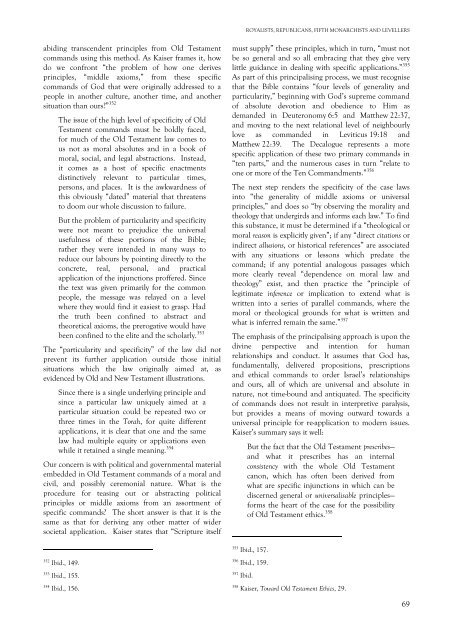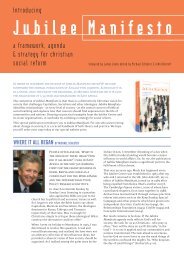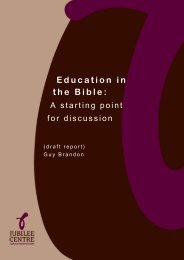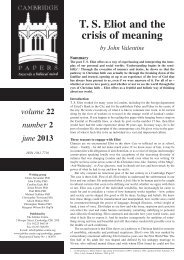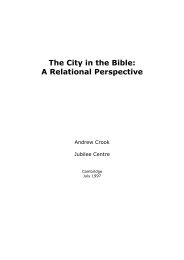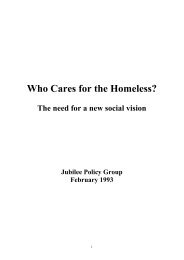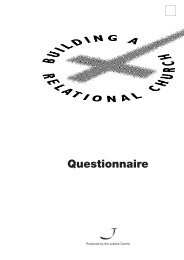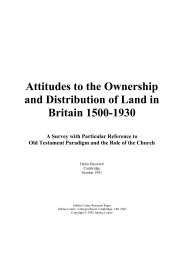Report Template - Jubilee Centre
Report Template - Jubilee Centre
Report Template - Jubilee Centre
Create successful ePaper yourself
Turn your PDF publications into a flip-book with our unique Google optimized e-Paper software.
ROYALISTS, REPUBLICANS, FIFTH MONARCHISTS AND LEVELLERS<br />
abiding transcendent principles from Old Testament<br />
commands using this method. As Kaiser frames it, how<br />
do we confront “the problem of how one derives<br />
principles, “middle axioms,” from these specific<br />
commands of God that were originally addressed to a<br />
people in another culture, another time, and another<br />
situation than ours?” 352<br />
The issue of the high level of specificity of Old<br />
Testament commands must be boldly faced,<br />
for much of the Old Testament law comes to<br />
us not as moral absolutes and in a book of<br />
moral, social, and legal abstractions. Instead,<br />
it comes as a host of specific enactments<br />
distinctively relevant to particular times,<br />
persons, and places. It is the awkwardness of<br />
this obviously “dated” material that threatens<br />
to doom our whole discussion to failure.<br />
But the problem of particularity and specificity<br />
were not meant to prejudice the universal<br />
usefulness of these portions of the Bible;<br />
rather they were intended in many ways to<br />
reduce our labours by pointing directly to the<br />
concrete, real, personal, and practical<br />
application of the injunctions proffered. Since<br />
the text was given primarily for the common<br />
people, the message was relayed on a level<br />
where they would find it easiest to grasp. Had<br />
the truth been confined to abstract and<br />
theoretical axioms, the prerogative would have<br />
been confined to the elite and the scholarly. 353<br />
The “particularity and specificity” of the law did not<br />
prevent its further application outside those initial<br />
situations which the law originally aimed at, as<br />
evidenced by Old and New Testament illustrations.<br />
Since there is a single underlying principle and<br />
since a particular law uniquely aimed at a<br />
particular situation could be repeated two or<br />
three times in the Torah, for quite different<br />
applications, it is clear that one and the same<br />
law had multiple equity or applications even<br />
while it retained a single meaning. 354<br />
Our concern is with political and governmental material<br />
embedded in Old Testament commands of a moral and<br />
civil, and possibly ceremonial nature. What is the<br />
procedure for teasing out or abstracting political<br />
principles or middle axioms from an assortment of<br />
specific commands? The short answer is that it is the<br />
same as that for deriving any other matter of wider<br />
societal application. Kaiser states that “Scripture itself<br />
must supply” these principles, which in turn, “must not<br />
be so general and so all embracing that they give very<br />
little guidance in dealing with specific applications.” 355<br />
As part of this principalising process, we must recognise<br />
that the Bible contains “four levels of generality and<br />
particularity,” beginning with God’s supreme command<br />
of absolute devotion and obedience to Him as<br />
demanded in Deuteronomy 6:5 and Matthew 22:37,<br />
and moving to the next relational level of neighbourly<br />
love as commanded in Leviticus 19:18 and<br />
Matthew 22:39. The Decalogue represents a more<br />
specific application of these two primary commands in<br />
“ten parts,” and the numerous cases in turn “relate to<br />
one or more of the Ten Commandments.” 356<br />
The next step renders the specificity of the case laws<br />
into “the generality of middle axioms or universal<br />
principles,” and does so “by observing the morality and<br />
theology that undergirds and informs each law.” To find<br />
this substance, it must be determined if a “theological or<br />
moral reason is explicitly given”; if any “direct citations or<br />
indirect allusions, or historical references” are associated<br />
with any situations or lessons which predate the<br />
command; if any potential analogous passages which<br />
more clearly reveal “dependence on moral law and<br />
theology” exist, and then practice the “principle of<br />
legitimate inference or implication to extend what is<br />
written into a series of parallel commands, where the<br />
moral or theological grounds for what is written and<br />
what is inferred remain the same.” 357<br />
The emphasis of the principalising approach is upon the<br />
divine perspective and intention for human<br />
relationships and conduct. It assumes that God has,<br />
fundamentally, delivered propositions, prescriptions<br />
and ethical commands to order Israel’s relationships<br />
and ours, all of which are universal and absolute in<br />
nature, not time-bound and antiquated. The specificity<br />
of commands does not result in interpretive paralysis,<br />
but provides a means of moving outward towards a<br />
universal principle for re-application to modern issues.<br />
Kaiser’s summary says it well:<br />
But the fact that the Old Testament prescribes—<br />
and what it prescribes has an internal<br />
consistency with the whole Old Testament<br />
canon, which has often been derived from<br />
what are specific injunctions in which can be<br />
discerned general or universalisable principles—<br />
forms the heart of the case for the possibility<br />
of Old Testament ethics. 358<br />
355<br />
Ibid., 157.<br />
352<br />
Ibid., 149.<br />
353<br />
Ibid., 155.<br />
354<br />
Ibid., 156.<br />
356<br />
Ibid., 159.<br />
357<br />
Ibid.<br />
358<br />
Kaiser, Toward Old Testament Ethics, 29.<br />
69


